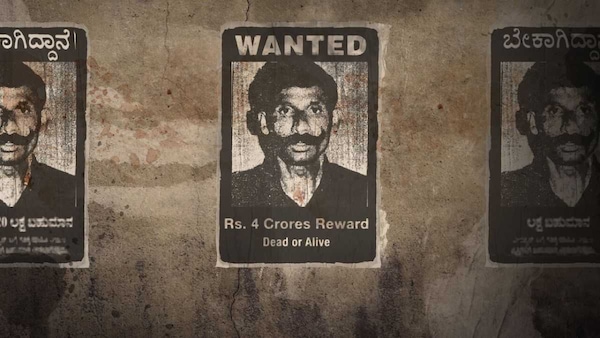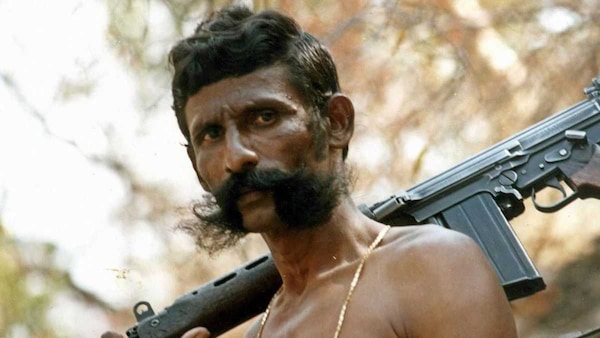The Hunt For Veerappan: Netflix Docu Uncovers The Man Behind The Outlaw
This is #CriticalMargin, where Ishita Sengupta gets contemplative over new Hindi films and shows. Today: Netflix docu-series The Hunt for Veerappan.

Last Updated: 12.27 PM, Sep 03, 2023
Selvamani Selvaraj’s The Hunt for Veerappan opens with a crucial query: Who is Veerappan? The question is as old as it is redundant. There is little about the dreaded outlaw that is unknown. His exploits which included the smuggling of sandalwood and ivory, his ability to use the forest as a shelter and cover for over three decades, his notorious kidnappings for ransom and killings of people, and his cruel death in 2004 have been part of public memory, so is that image of a gaunt man donning an enormous moustache with a rifle in hand. But in Selvaraj’s urgent outing on the bandit, this procedural-tied probe is answered with touching warmth. “Who is Veerappan?” “My husband” comes the reply.
In more ways than one the distinct nature of this exchange, where a familiar narrative is rendered an intimacy of access, defines Selvaraj’s fascinating new non-fiction. The four-part docu-series tells a story that is known to all but the filmmaker punctuates it with empathetic curiosity and investigative rigour resulting in a complexity that reveals more than it shows. The Hunt for Veerappan is at once a case study in storytelling economy and a sincere intent that translates into leaning on facts more than sensationalism.
Selvaraj designs the biography in four episodes– one delves into Veerappan’s rise in notoriety, “The Forest King”, followed by a deep dive into his violent streak, “The Bloodbath”. The last two episodes are titled “The Revolutionary” and “The Way Out”. These broad strokes encapsulate the bloody legacy of the dacoit, delving deep into his psyche- his refusal to discriminate between caste and creed, the stealth with which he inhabited the forests in the southern parts of India (Sathyamangalam forest is generally associated with him), his inclination to be remembered more than just an outlaw. Later in life, he associated with the Liberation Tigers of Tamil Eelam (LTTE) and kidnapped the celebrated Kannada film actor Rajkumar on July 30, 2000 to put forth their cause.
The outline is vast and deployed with austerity. The documentary is filled with talking heads – his wife Muthulakshmi makes an appearance and so do various retired officials from the Special Task Force (STF) that was instituted to find Veerappan. If this hints at a polarity in opinions, it is only exacerbated with the inclusion of a former member of his gang, an informer who still swears by Veerappan’s kindness. The narrative that emerges from this is as interesting as it is riveting. When one of the officers remembers P. Srinivas, a forest officer who was keen on reforming Veerappan (and later killed by him), stories of his kindness halt at Muthulakshmi’s face who dismisses them as manipulative. Both sides are held together by the presence of journalist Sunaad Raghuram. He has authored books on Veerappan and his factual perception, along with photojournalist Sivasubramanian streamline the ambivalence stemming from the two sides.
On paper, Selvaraj’s work is about a person told through people who knew him and knew of him. This lends itself to rare details which contribute to a fuller representation of a man whose repute remains shrouded in myths. For instance, while an officer shares Veerappan’s cruelty which extended to killing men in uniform with a vengeance, his wife recalls a particular tenderness with which he had proposed marriage. In his request, he had stated that if she refuses, he will not look at another girl again and his heart will turn to stone. She was a teenager and he was 39.
The manhunt itself is relayed with compelling intensity, aided by archival images and insights. The final stretch on Veerappan’s captivity and death is an instance of sensational storytelling. When the moment arrives in the documentary, it ceases to matter that we heard of it before. Selvaraj (who was an assistant director to Ang Lee in Life of Pi) displays exceeding control over his craft as he reiterates the questions surrounding Veerappan’s death (many claim he was tortured by the cops before being shot, a version the officials deny) without diluting what he chooses to depict.
But what makes The Hunt for Veerappan more than a regular procedural nonfiction, and a departure from the other template-driven true crime nonfiction titles on Netflix, is its ability to look deeper into obvious facts. For instance, it cuts through the origin story and arrives straight at Veerappan’s birthplace. Through footage of Gopinatham in Karnataka, the abject poverty of the people is conveyed. This at once lends a social and cultural context to the mythology of Veerappan. This further extends in the way Selvaraj looks at the machinery of power and the way in their blind search for a criminal they too had started emulating his cruelty. In the story of the manhunt, the roles of the hunter and the hunted kept changing faces.
There are moments in The Hunt for Veerappan where an officer recounts tales of the bravery of another officer and Selvaraj pairs it with Sunaad or Muthulakshmi harping on their brutality. It makes for a poignant combination precisely for the accuracy with which it underlines procedural torture and the swiftness with which cruelty counts to be bravery when the doer is in uniform. There are also instances when a voice from the other side of the camera intervenes directly, interjecting a former STF officer’s story with a “but was that right?” query. Although the filmmaker does not include the 1992 Vachathi case (in which 155 forest officials, 108 police officers, and six revenue officers had entered the village in Tamil Nadu and raped women and assaulted men under the pretext of them helping Veerappan), he delves deep into the workshops arranged by former Commissioner Shankar M Bidari which became sites of mass arrests and torture. The documentary then also doubles up as the acknowledgement of the casualty caused by the sustained collision of the two parties.

This retention of a humane core amidst the bloodshed results in an affecting documentation of Veerappan and Muthulakshmi's relationship, the trials and tribulations of their marriage, the grief of remaining apart and the joy of togetherness. The third episode concludes with moving sentimentality where Veerappan’s audio tapes recorded for his wife are played in the background as we see her riding a scooter, in a present, lonelier time. The promise of kinship has long expired and what remains is a woman who spent most of her life waiting. Selvaraj’s recognition of this counts for the documentary’s biggest triumph.
The Hunt for Veerappan is also, and perhaps more so, the story of Muthulakshmi. Famed for her beauty in her youth, she spent most of her life either waiting for her husband or facing consequences for his actions. She has been in jail and tortured by the cops. There is no regret nor remorse on the face we see in the documentary as she sits, visibly still proud of her husband’s courage. Even today, she sees herself still through his reflection. In the final moments of the nonfiction, the interviewer chimes in and asks what bravery is for her. “Bravery is being absolutely fearless, no matter what the problems are one should face them and live in this world. One should work hard and keep moving forward.” Muthulakshmi says, still speaking about Veerappan without taking his name. At this juncture, the voice from the other side says, “To me, the act of killing is not bravery.” Muthulakshmi sits disarmed. Her expression changes ever so slightly as if finally realising that if bravery is what she thinks it to be, then she has been the bravest of them all.

